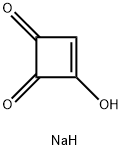Chemical Properties
Solid
Uses
Moniliformin is a potent, water-soluble mycotoxin produced by several species of Fusarium. Comparative toxicity studies of moniliformin in chicken cell lines revealed no toxicity to chondrocytes and macrophages, but toxicity to splenocytes, cardiac and skeletal myocytes. Moniliformin selectively inhibits mitochondrial oxidization of pyruvate and α-ketoglutarate, however the mode of action is not yet completely resolved.
General Description
Moniliformin (MON), a mycotoxin and small ionic molecule, is present in various Fusarium species including Fusarium avenaceum, Fusarium subglutinans and Fusarium proliferatum. It is present as sodium or potassium salt of semisquaric acid naturally. MON is also present in maize and small-grain cereals.
Biological Activity
Mycotoxin.
Biochem/physiol Actions
Moniliformin (MON) is implicated for its toxic potential and may lead to respiratory distress and progressive muscular weakness in rats. It inhibits the tricarboxylic acid (TCA) cycle oxidation step. By acting as a pyruvate substrate, MON effectively inhibits thiamine pyrophosphate cofactor dependant enzymes and blocks the gluconeogenesis pathway. ) Furthermore, MON also inhibits glutathione peroxidase and glutathione reductase leading to oxidative stress in myoblast.
in vitro
moniliformin, first isolated as a mycotoxin from fusarium moniliforme, was found to be phytotoxic and arrests mitosis of maize root meristematic cells at the metaphase stage. the mitotic spindle could be disrupted by the treatment of moniliformin, but no direct effect on tubulin had been observed [1].
in vivo
a previous study was conducted on rat heart to in situ determine the myocardial toxicity of moniliformin, originally isolated from mouldy corn and soil samples in the keshan disease prevalent area in china. results showed that perfusion of moniliformin 10-7 mol/liter in isolated heart decreased myocardial contractile force by 52%. intravenous injection of moniliformin at 1/6 and 1/4 ld50 could markedly inhibit cardiac hemodynamic variables associated with myocardial contractile function. moreover, moniliformin was able to decrease +/- lv dp/dt max by 52%, and induce ventricular arrhythmia. these findings indicated that moniliformin was toxic to mammalian heart and might be an important factor relative to keshan disease [2].
References
[1] duke, s. o. and dayan, f.e. modes of action of microbially-produced phytotoxins. toxins (basel) 3(8), 1038-1064 (2011).
[2] fan ll, li j, sun lh. effect of moniliformin on myocardial contractility in rats. biomed environ sci. 1991 sep;4(3):290-4.
